Indeed, as the former head of marketing at two different startups, I’ve seen firsthand just how frustrating it can be for a growing business to keep track of its customers. At the same time, I know all too well that there are hundreds of CRMs to choose from, and even once you’ve chosen one, the best way to get it up and running can be far from obvious.
That’s why I decided to write this article. In this comprehensive guide to CRMs, I’ll start by walking through what a CRM is and discussing some of the key benefits and features they offer. Then, I’ll offer some tips on how to choose the best CRM for your business needs, before sharing some of my favorite CRM best practices.
Table of Contents
- What Is a CRM?
- Does My Company Need a CRM?
- What Are the Benefits of CRMs?
- What Are the Core Features of a CRM?
- Choosing the Right CRM
- Best Practices for Using CRMs
- Advanced CRM Best Practices
What Is a CRM?
CRM, or Customer Relationship Management, refers to a strategy or system that companies use to track information about interactions that clients and prospects have with employees, websites, or other touchpoints, such as email, phone, live chat, and social media. These systems offer marketing and sales teams detailed context about their clients’ activity and feedback, empowering them to provide a personalized experience and make data-driven decisions.
For example, the screenshot below shows a CRM dashboard that displays deal forecasts, a sales pipeline, and deals closed against quota for a given month:
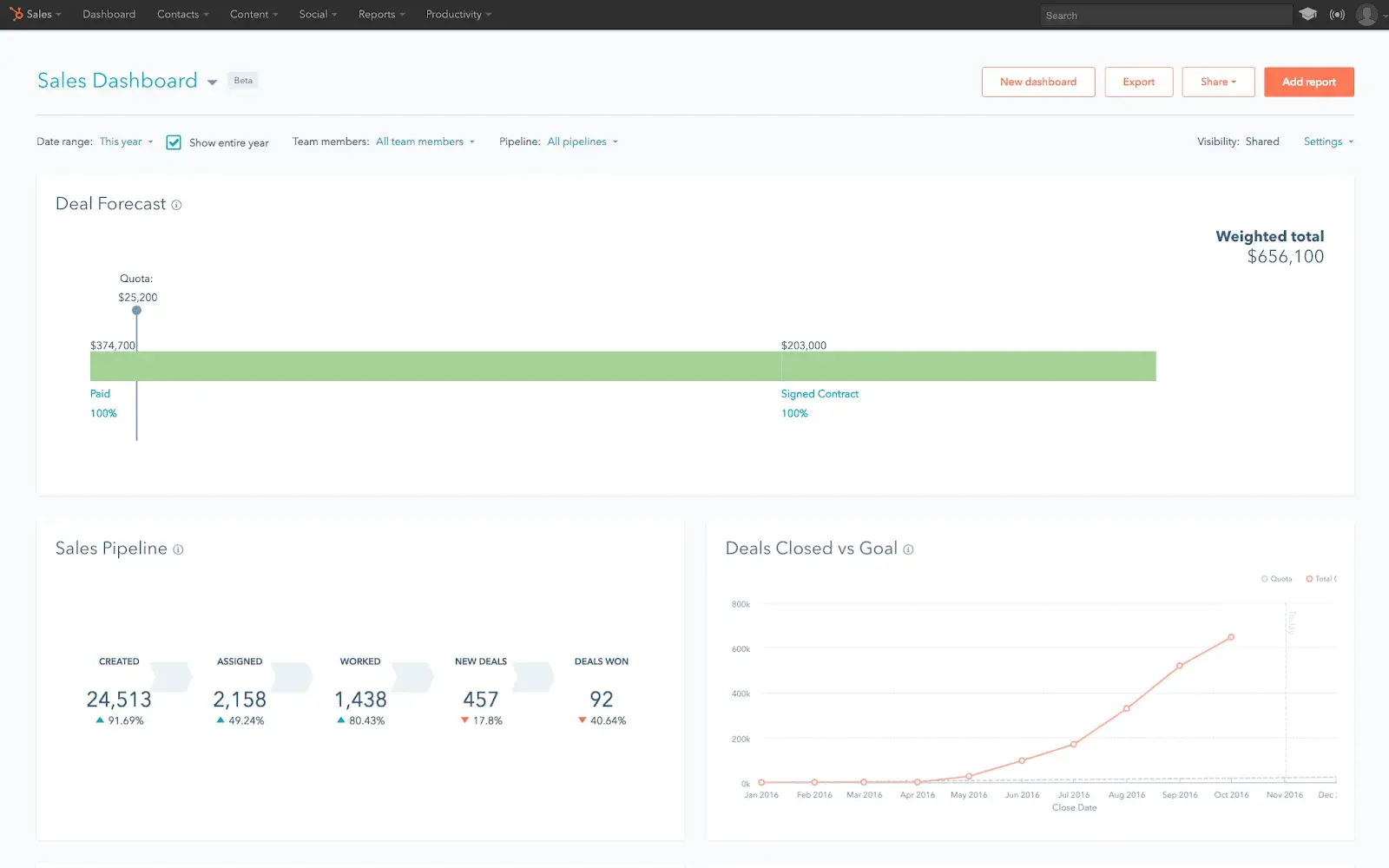
Historically, CRMs largely served as passive tools to manage data. But more recently, the integration of AI-powered features into many CRMs have made it possible for these systems not only to organize and display information, but also to proactively analyze that information and offer actionable, intelligent insights. In fact, while AI isn’t without its fair share of critics, I’d argue AI has dramatically improved the effectiveness of today’s CRMs.
As John Cheney, CEO of the CRM platform Workbooks, explains, “AI offers the potential to revolutionize CRM by automating tasks, providing predictive insights, and personalizing customer experiences.”
Of course, AI-powered CRMs are no panacea — but I believe that when used effectively, they can be incredibly powerful tools.
Does My Company Need a CRM?
In case it wasn’t obvious, I’m definitely a fan of CRMs. But that doesn’t mean every company needs one. To the contrary, there are really just two types of companies that are most likely to benefit from leveraging a CRM:
- B2B companies that track leads across longer, consultative sales cycles and through upgrade paths (e.g., software companies, agencies, or recruiting firms).
- Considered-purchase B2C companies (e.g., realtors, financial services, or landscaping services).
Of course, even for companies that fall into one of these two categories, it’s not a given that a CRM is necessary. To figure out whether your specific company needs a CRM, ask yourself the following questions:
- Do I need records of information about my prospects and customers?
- Does that information currently live in many different places?
- Is it becoming difficult to manage my data?
- Do my customers regularly interact with multiple people on my team?
- Do I need a better way to measure my sales team’s productivity?
- Is my team getting slowed down because they have to jump between different systems to find data about leads or customers?
If you answered ‘yes’ to any of the questions above, your business might benefit from a CRM. And take it from me: Adopting one sooner rather than later will help you avoid frustration and save you countless future headaches.
What Are the Benefits of CRMs?
Over the course of my career, I’ve learned time and again that a business’s most valuable and important asset is its customer base. But unfortunately, at many companies, knowledge about customers is stored in lots of different places, from the CEO’s brain to a sales rep’s inbox, an accountant’s records, or even a spreadsheet.
The problem with this disconnected approach is that as your company grows, it becomes harder and harder for your sales team to find information about customers and prospects. As a result, sales processes become increasingly time-consuming and frustrating — and that means both your team and your customers suffer.
CRMs exist to solve this problem. At a high level, the core benefit of a CRM system is that it offers a central database for all of your customer information. More specifically, there are five key benefits of CRMs.
Automated Data Management
By organizing all lead and customer information in one place and automating data entry, CRM software makes it easy to run the sales process smoothly.
Sales Reporting
A CRM can track quota attainment and activity metrics such as emails sent, calls made, meetings booked, opportunities created, and deals closed.
Accurate Sales Forecasting
Rather than relying on complicated formulas or back-of-the-napkin math, a CRM can generate an accurate sales funnel, making it easier to forecast future sales and effectively manage your team’s pipeline.
Customer Segmentation
By segmenting prospects based on parameters such as location, deal size, or close date, you can identify specific regions or industries to sell into and benchmark your average sales cycle.
Scaling a Sales Process
To grow your business, you need to test out different strategies — and without the information stored in a CRM, you’ll be shooting in the dark. A CRM offers visibility into the data you need to spot behavioral patterns, identify trends, and distinguish effective sales tactics from ineffective ones.
What Are the Core Features of a CRM?
Clearly, CRMs offer many benefits to businesses. But how exactly do they work, and what exactly do they offer?
Basic CRM Features
The core features of a CRM include the following:
- Contact management. CRMs provide a searchable database to store customer and prospect information and relevant documents.
- Pipeline management and sales forecasting. A CRM makes it easy to visualize your entire sales pipeline, as well as to move deals from one sales process stage to another. In other words, no more mental math to figure out what’s closing this month!
- Reporting and analytics. Sales leaders can use their CRM to track their team’s activity and revenue growth to guide both team coaching and sales forecasting.
- Process standardization. CRMs help standardize business processes through unified task lists, calendars, alerts, and templates.
Advanced CRM Features
Beyond these basic features, other features that a CRM system may provide include:
- Email integration. Many CRMs can integrate with your existing email client, making it possible to log prospect interactions automatically and pull useful context right into your inbox. This integration eliminates a substantial amount of manual data entry, and as such I’ve found that it’s a major factor in determining whether your sales team will actually use the CRM.
- Email tracking. With email tracking, reps will know if their email was opened, if a link in their email was clicked, or if a document was viewed. These insights empower them to follow up more effectively.
- Call recording. With call recording capabilities, reps can call prospects directly from the CRM and log the interaction, making it easier for managers to coach salespeople.
- Interaction tracking. A CRM can streamline a sales rep’s day by automatically logging information about any touchpoint with a prospect (like an email, phone call, social media message, or website visit). For example, this screenshot illustrates the wide range of interactions that a CRM can track:
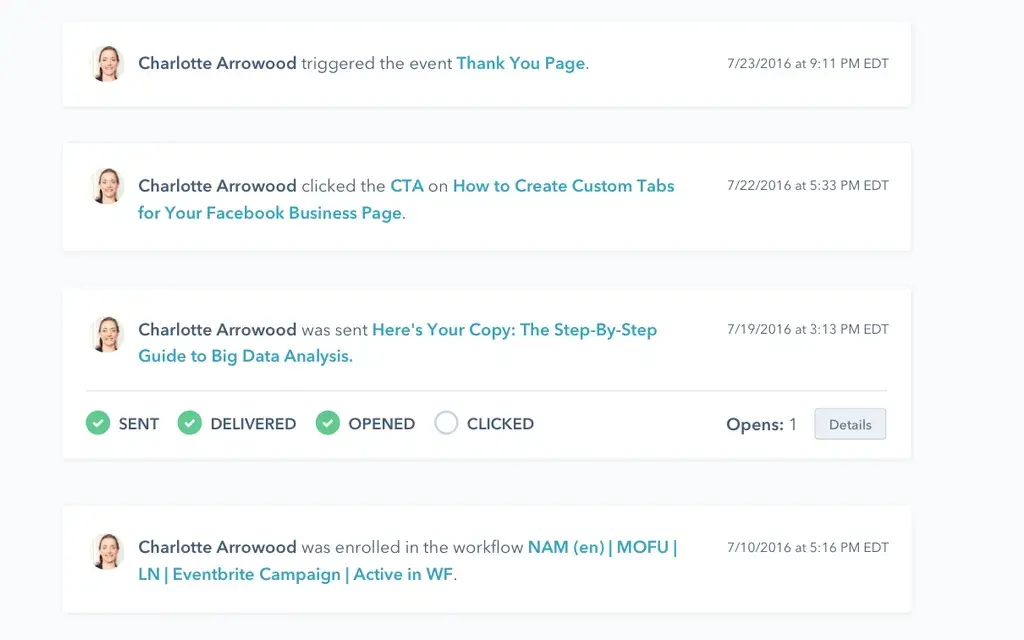
- Software integrations. Most organizations use a lot of different software systems. A CRM that can integrate with your existing tools will minimize the time your reps spend switching between various apps.
- Leaderboards. Some CRMs foster friendly competition with leaderboards that track and display your salespeople’s activity levels and forecasted pipelines.
- Mobile CRM. A mobile-friendly CRM is especially important for sales reps that are often on the go, as it makes it possible for them to access the platform outside of the office. That’s a big part of why research shows that mobile CRMs are associated with sales teams achieving their quotas.
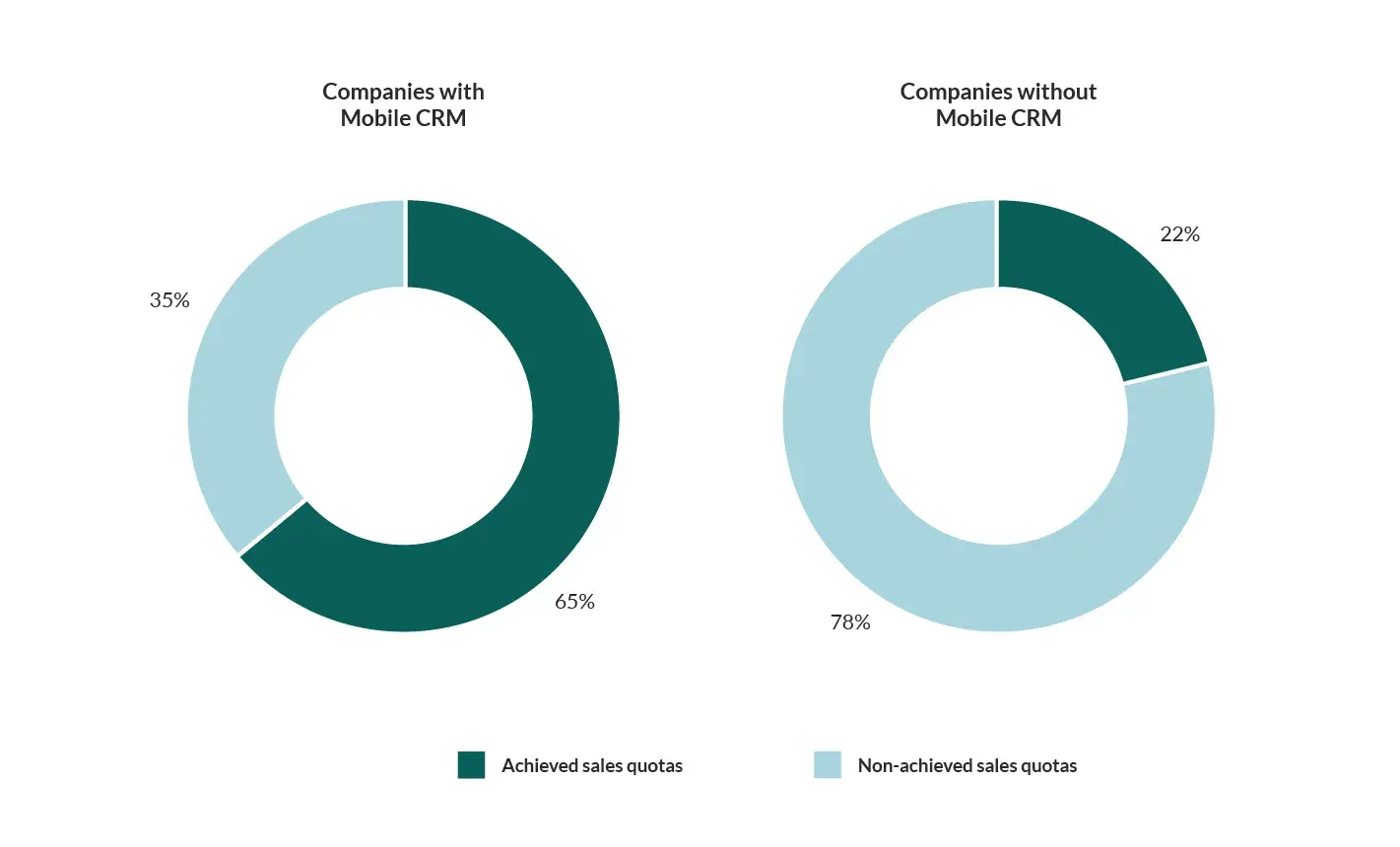
AI CRM Features
Finally, in addition to the standard and advanced features available with traditional CRMs, new advances in AI technologies have enabled a number of new, AI-powered CRM features:
- Chatbots. One of my favorite AI CRM features are chatbots. A chatbot can use generative AI to answer questions and provide a first round of qualification before a lead talks to a human rep, saving sales teams substantial time.
- Call analysis. Especially for more junior sales reps, analyzing call recordings is critical to gather feedback and help people improve. Unfortunately, this process can be highly time-consuming. That’s where AI comes in. An automated, AI-powered tool can analyze call recordings for you, extracting actionable insights and areas for improvement at the click of a button.
- Data cleaning. If your spreadsheets are anything like mine, they’re probably full of duplicate data, inconsistencies, and other issues. With an AI-powered CRM, you can quickly and easily clean your data, ensuring you never miss an update or confuse one customer for another.
- Customer insights. Another one of my favorite things about AI-powered CRMs is that they can offer automated, data-driven insights into customer trends. Armed with this information, I can easily identify top priority leads and opportunities to improve my sales process.
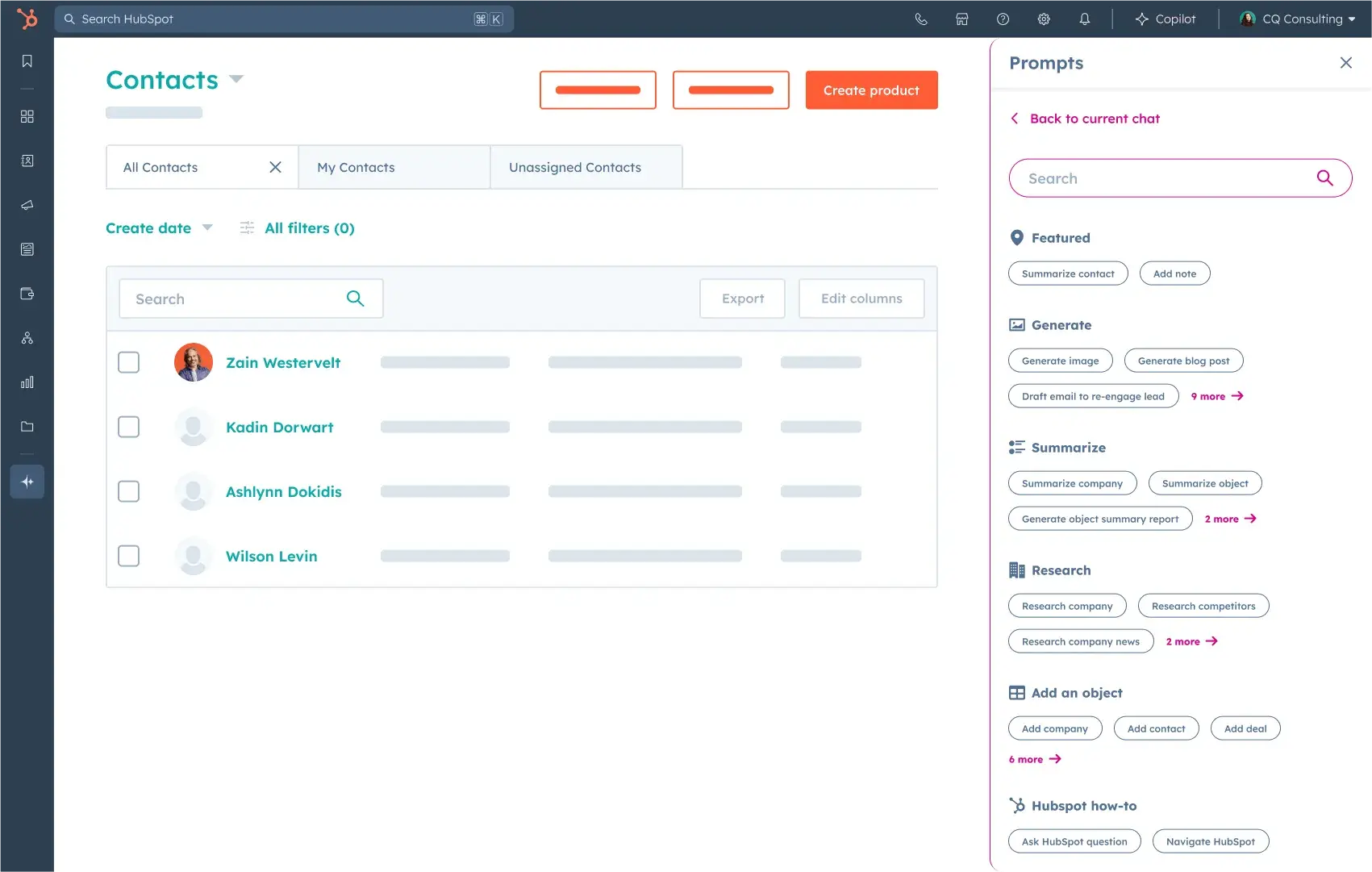
As CRM expert Steve Chipman explains, “Combining generative AI with CRM allows companies to better automate business processes, develop more personalized communications, and provide customers with the most helpful answers to questions.”
While AI can’t solve all our problems, AI CRM features can add a huge amount of value to a sales or marketing team.
Choosing the Right CRM
Choosing the right CRM can be a daunting task. But before you can evaluate the options, it’s important to understand what you’re looking for by asking yourself these questions:
- Why are we investing in CRM?
- What operational business challenges do we need to solve?
- What processes do we lack that we should implement?
- How many people do I expect to use the CRM?
- How much customer information do we have?
- What other software do we use that the CRM should integrate with?
- How much budget do I have?
By thinking through these questions, you’ll start to hone in on the areas that can offer real business value to your company.
https://youtu.be/d-_X1tXFu9M?si=4bsBi5apyRYGKi6j
In addition, I’ve found that using a more robust system usually means you’ll have to invest more in setup and customization, which can be a waste of resources if your challenges can be addressed by a more basic CRM system. As such, it’s generally much easier to start with a simpler CRM and move to a more comprehensive solution later on.
Finally, once you’ve narrowed down that kinds of features you’re interested in, I suggest taking the following steps to make your choice:
- Contact your top CRM vendors and review your list of requirements with their sales reps.
- Read product reviews and ask your peers which system they use.
- Compare prices and focus on getting the features you need.
Pro tip: Some of my favorite CRMs for small businesses include HubSpot CRM, Finances Online, Zoho CRM, Pipedrive CRM, Agile CRM, and Insightly CRM. But ultimately, no one can make this decision for you. So, choose the CRM software that you think will be best for your needs, and stick to your decision. After all, indecisiveness can cost a lot of time and money.
Best Practices for Using CRMs
Once you’ve identified the features you need and selected your CRM platform, it’s time to get started with implementation. Below, I’ve compiled some of my top tips for setting up a CRM effectively — and for getting as much value out of it as possible, long-term.
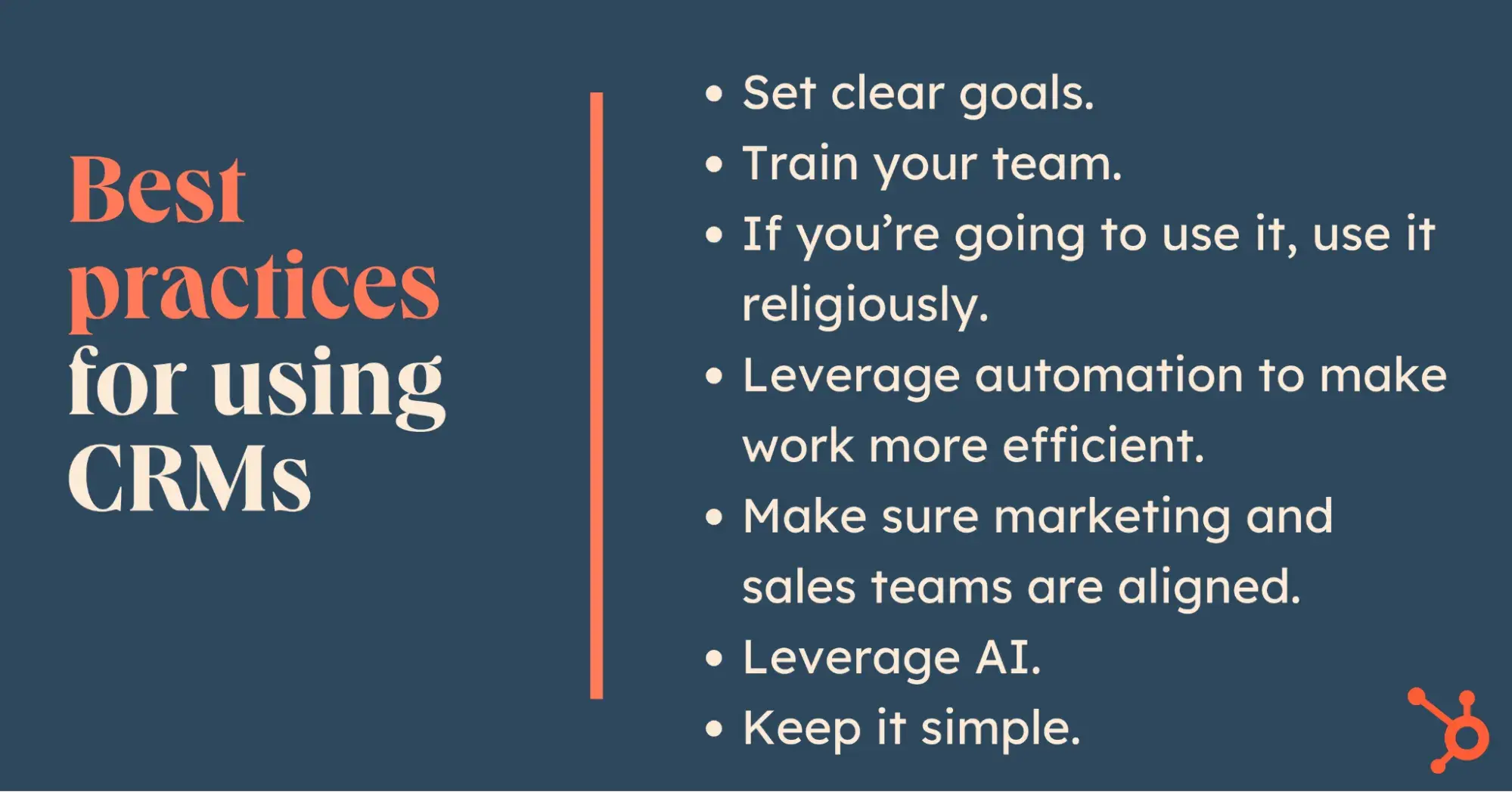
1. Set clear goals.
First and foremost, it’s essential to set clear, well-defined goals. In my experience, the best goals are SMART: they’re Specific, Measurable, Achievable, Relevant, and Time-Bound.
Defining a small number of specific goals in this way will help to make sure you prioritize setting up and using the most important CRM features for your organization. For example, if you’re looking to boost your team’s efficiency, focusing on automating tasks such as customer outreach, followup, and invoicing may make sense.
As SEO expert Justin Lafferty argues, it’s important “to make sure your CRM goals are aligned with your overall business objectives.” He continues, “Define measurable and realistic goals for how you would like the CRM to help your teams succeed. Over time, you can track those goals and adjust them as needed.”
2. Train your team.
Next, I’ve learned firsthand that training is a vital part of any CRM implementation plan. You can set up the best tool in the world — but if no one knows how to use it, it’s not going to add much value.
Small business marketing expert Janette Novak says it best: “Weak user adoption is a key reason CRMs fail. If your team does not understand the immense benefits of your CRM or is not properly trained on how to use your CRM correctly, your CRM is doomed. That’s why developing an effective user training program is a crucial CRM best practice.”
To train your team effectively, make sure to identify all the people who might need to use the CRM. Then, share resources and set up training sessions to walk everyone through the tool. I’ve also found that it can be helpful to establish a dedicated channel for people to ask questions and share their own tips and tricks. Whether that’s a Slack channel, a recurring meeting, or even just a chalkboard in a common area where people can add notes and questions, creating a space for people to learn together is a great way to get everyone up to speed.
3. If you’re going to use it, use it religiously.
Stephanie Henson, sales and marketing director at Six Ticks Limited, has managed remote teams for more than ten years. Naturally, with a remote team, organization is key. To get the most out of your CRM and to operate with streamlined processes, Henson says you need to use it consistently.
She explains, “You need to be disciplined with using your CRM, no toe in the water stuff. If you’re using it, use it religiously.” According to Henson, using your CRM religiously means importing only the best data. After all, your CRM can only be as good as the data you put into it.
Henson continues, “Spending the time on cleansing your data before you import it will save you so much time in the long run.”
Remember: You can’t expect the system to work magic. You have to use it properly for the magic to happen. All too often, people change CRM systems, or continue to half-use them, and then complain they don’t work. As Henson warns, “Good implementation is key. Skip or rush this step, and you’re heading for pain.”
Pro tip: Henson recognizes that CRM implementation won’t do all the heavy lifting without careful human administration, especially when you’re still getting started.
4. Leverage automation to make work more efficient.
Maret Reutelingsperger is a digital communications consultant at Mobe Digital, where she focuses on marketing and sales implementations. She recognizes that sales teams are really busy, and one of the best ways to keep them on track is through automation.
As Reutelingsperger recommends, “Make sure that sales keep on top of their deals, so that they don’t fall through the cracks. Use automation! Whether it’s creating a task for the deal owner when a deal reaches a certain stage or sending internal emails to deal owners of inactive deals, having these little nudges can be just the thing to remind the team of deals that can be worked further.”
If you use your CRM’s automation capabilities, you’ll help keep your team from missing leads and reduce the chances of human error.
Reutelingsperger continues, “For those with recurring contracts, this can even go a step further and use contract signed date to ensure the conversation gets picked up ahead of the next contract signing. This gives the sales team plenty of time to ensure all services are going well and planning ahead for their new proposal.”
Pro tip: CRM automation can keep the most important to-do’s at the forefront of your reps’ minds. For example, if they get a notification before a customer’s next signing is due, your sales reps can chat with the customer to provide the timely information they need … and avoid missing the deadline.
5. Make sure marketing and sales teams are aligned.
If you’re using your CRM efficiently, then you most likely have multiple teams — in particular, sales and marketing teams — using the system. The idea is for everyone to use the tool to work together in pursuit of a common goal. But of course, as we all know, that isn’t always what happens.
Reutelingsperger has a solution for this, too. She says, “Marketing teams love asking questions, setting up forms, and learning more about the contacts as they go through the buyer journey. But what are the pieces of information that are really valuable to the sales team? Often, this gets overlooked.”
To solve this problem, Reutelingsperger suggests having regular meetings between marketing and sales to talk about information that will help both teams improve.
“For the sales team — make clear what information the marketing team should be asking for,” she says. “And the other way around, what questions are asked a lot during the sales process? This is content that can be invaluable for the marketing team. Help each other, to help each other.”
Pro tip: Marketing and sales both work better when they work together. Meetings to discuss each department’s needs aid understanding and bolster feedback loops between teams. After all, you want your teams to work with each other, not against each other.
6. Leverage AI.
Today, many CRMs come with a range of AI features built in. These tools have the potential to add a huge amount of value — but they’ll only realize that potential if you actually use them.
So, don’t be afraid to dive into the world of AI. From chatbots to automated call analysis to data-driven customer insights, AI-powered CRMs have a lot to offer. In my experience, if you’re not sure where to start, it can help to dip your toe in the water by just adopting one AI feature. Then, once you’ve gotten used to that, you can try adding some more.
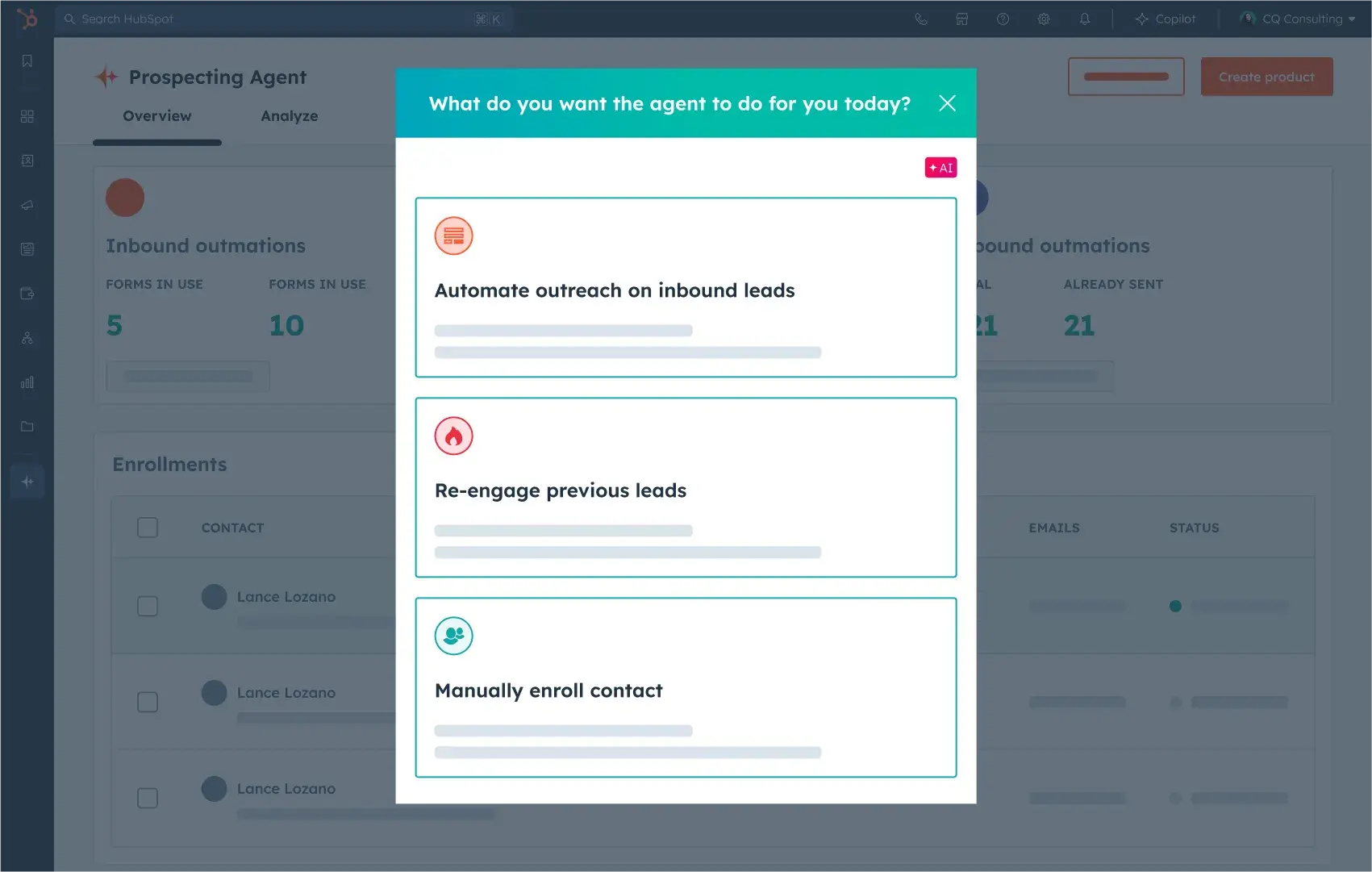
7. Keep it simple.
CRM systems can do a lot, and it’s easy to get lost or overwhelmed by the features available to you. As a result, the key to success is to identify exactly what you need to report on and why before you jump in with a new CRM.
Chris Pallet, founder and managing director at Bespoke Computing, provides his clients with advice and guidance on tech and software selection. He warns, “It’s very easy to get lost in the rabbit hole of what a CRM will or won’t do.”
Pallet’s top best practice for CRM implementation is to keep it simple. As he explains, “To quote Simon Sinek: ‘Start with why.’ Why is the business looking at this, to begin with? What questions/answers is it looking to understand?”
Pallet notes that there are many dimensions to data, but only one to two may be truly important for a given sales team (whether that’s lead sources, conversion rates, sales days, or staff performance). He continues, “what’s the cost of not having the information vs. the cost of implementation? Those data points might drive your reporting, and make sure the software can drive those reports.” Another question to ask yourself is, “How does the data get caught and put into the system?” Pallet notes that it’s important to ask these key questions “before you consider splashing any cash on the software itself.”
Pro tip: Pallet encourages sales teams to think about what they actually want their CRM to do … before they integrate it into their processes.
Additionally, Pallet suggests conducting a cost-benefit analysis to see if access to the information that the CRM will provide is actually worth it. Having a CRM is one thing, but someone also needs to populate the CRM so you can get the most out of it, which can have a substantial near-term impact on workloads.
Advanced CRM Best Practices
1. Set up essential reports.
Wasif Kasim, a sales and marketing consultant, recommends that users don’t set up their own CRM and instead use a partner. After all, working with someone who’s been there and done it can help a lot. He warns that those who set up their own CRM may regret it later. But for those who do feel confident setting up their own system, Kasim recommends starting with the following reports:
Sales Reports
- Leads not contacted
- Marketing leads contacted once, but not followed up for over 3 days
- Deals that have not been followed up for > 7 days
Marketing Reports
- Number of marketing leads per month, per channel
- $ value of deals created from marketing leads, per month, per channel
- $ value of deals closed won from marketing leads, per month, per channel
- $ value of deals won from marketing lead sources versus non-marketing lead sources
Customer Success Reports
- Number of current clients not contacted in > 7 days
- Customer satisfaction score per customer, by month
- Customer satisfaction score per customer, by month, by account manager
2. Integrate calendars and landing pages.
Boomtag Media CEO Kendra Noel uses HubSpot’s CRM and recommends integrating calendars and landing pages for leads. With these integrations, she notes that you can use your CRM to do some of the administrative work for you, streamlining internal processes and preventing human error.
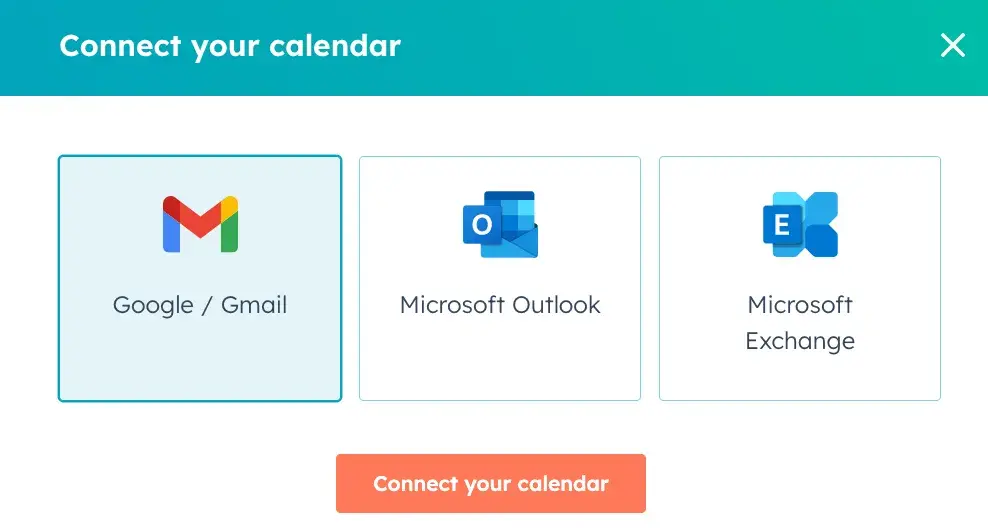
As she explains, “Leads automatically go to my CRM, and it gives the ability to send marketing emails and track those leads.” After all, it’s easy to miss a step and forget to update your CRM. With your CRM being automatically populated, you’ll never overlook an opportunity to keep your prospects in the know through email marketing.
Pro tip: Automation and integration are great ways to streamline processes, empowering sales teams to get the most out of their CRMs.
3. Get buy-in and develop SOPs.
Emma Schermer Tamir, ecommerce branding strategist at Marketing by Emma, recommends that you get clear buy-in from your team and then develop clear SOPs to ensure the CRM is used to its full potential. Importantly, SOPs only work if everyone agrees to use them and follows the same process.
As Tamir explains, imagine that “a salesperson is speaking with a prospect about their Amazon business [and] that person shares some of their struggles, future plans, and that they recently went viral on TikTok. At this stage, the salesperson needs to add these details into the CRM.”
When it comes to CRM management, Tamir notes that establishing easy-to-follow processes keeps people on the same page and delivers a seamless customer experience. When done right, SOPs help teams feel less stressed about things getting forgotten or missed.
At the end of the day, Tamir reflects that “information is only valuable if it’s visible. CRMs hold a lot of information, so you need to make sure you have a way for team members to see important details…Without a clear SOP of how to use and store this information, it will likely get lost in the shuffle.”
Pro tip: Tamir reminds us to use our CRMs to the fullest, but also to set up SOPs so everyone knows what the standard process is.
4. Use segmentation for personalization.
Katie White, content marketing manager at Centime, recommends segmenting your audiences into smaller groups so you can apply personalized marketing and messaging.
“One best practice I highly recommend when using a CRM system, like HubSpot, is to utilize its segmentation capabilities. Segmentation allows you to divide your customer base into smaller groups based on specific criteria, such as industry, job title, or behavioral patterns,” she shares.
For example, in HubSpot, you can create “active lists” that automatically update based on set criteria. This enables more personalized and targeted communication strategies. Instead of sending generic messages to your entire database, you can tailor your outreach to address the unique needs and interests of each segment.
This level of personalization can significantly improve engagement, lead nurturing, and ultimately, conversion rates. By leveraging segmentation in your CRM, you’re not only managing customer relationships but also optimizing them for better business outcomes.
Pro tip: I’ve learned that data personalization can be highly impactful in marketing — and effectively personalizing your messages is only possible if you segment your audience.
5. Set up lead scoring.
With lead scoring, your CRM can do some of the thinking for you. Lead scoring enables you to develop a deeper understanding of your customer, their interests, and their needs, helping you communicate with them in the most effective way possible.
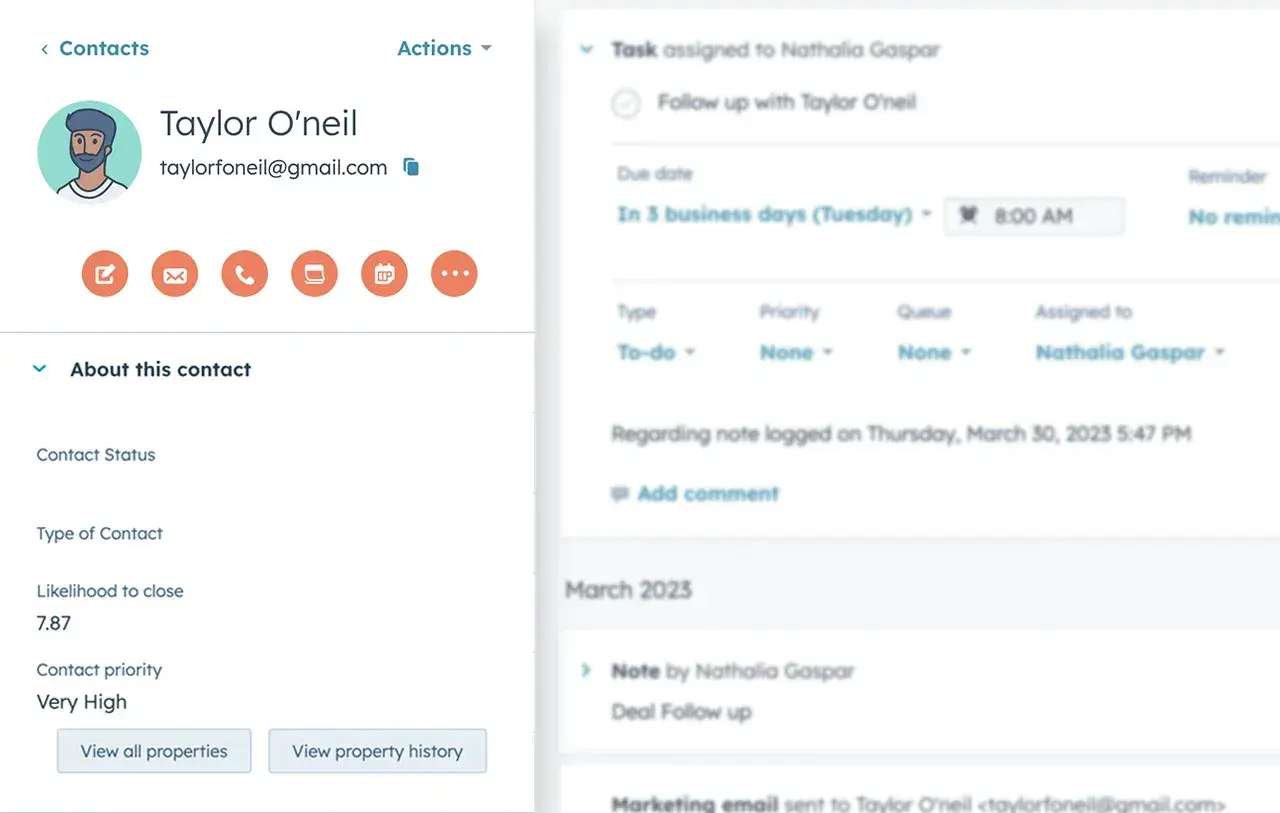
Amber Vellacott, marketing manager at MyArtBroker, uses HubSpot CRM and shares the importance of setting up lead scoring for sales and marketing: “It takes some getting your head around for sure. But work out what qualifies your leads as important to you or actions that show intent to your desired conversion.”
For example, Vellacott’s team focuses on page views for conversion-based content, with a particular eye toward the frequency and recency of those page views. She explains, “Your scoring can lead to you making active segmentation that updates as per your scoring criteria … You can then use this segmentation to prioritize the sales team communications and use smart modules in marketing emails. All enhancing brand touchpoints!”
Pro tip: A CRM with AI can analyze large data sets, helping sales teams discern who the strongest leads are. Armed with these insights, reps can focus on the leads who are most likely to convert, enabling them to put their human touch where it’s needed the most.
6. Enhance your data with workflows.
Maret Reutelingsperger of Mobe Digital offers another helpful recommendation: enhancing data with workflows. She says, “Using a CRM with workflow functionality can ensure that teams work with the best and most consistent set of information.”
Reutelingsperger notes that workflows ensure that data is consistent across different areas of the CRM, and that important information gets shared with others where relevant and useful. She continues, “For example, you can use workflows to ensure Deals are enhanced with information from associated Companies and Contacts and even Tickets (for cross-sells or upsells). This can give the sales team a quick and easy overview of anything that may affect the sale going ahead.”
Pro tip: More than just a customer relationship manager, your CRM can manage your internal team, too. Reutelingsperger encourages CRM users to set up workflows to streamline internal processes.
7. Turn customers into brand advocates.
In my experience, it can be very tempting for a sales team to focus exclusively on closing new deals. But what about retaining and upselling existing customers?
Richard Marriott, senior partner at Scaled, advises that teams can use their CRM to power post-purchase engagement, turning their customers into loyal brand advocates. He reflects, “A lot of focus is placed on top of funnel demand for net-new leads and then the handoff from marketing to sales, sometimes without much emphasis on post-purchase experience and customer nurture.”
To be sure, the top of the funnel is important too … but Marriott recommends that sales reps “think of your CRM as perpetual to continuously develop the view of your high-value customers, improve retention and renewals through nurture, and turn customers into brand evangelists.”
Pro tip: After a sale has been made, your work isn’t done: You have the opportunity to turn your new customer into a long-term brand advocate, inspiring them to continue using your product or service and even recommend you to their friends.
Getting Started with Your New CRM
Ready to get started? Click below to get started with HubSpot CRM. Once you create an account, take these steps to get set up and start seeing the benefits of a CRM immediately:
- First, migrate your existing data (whether from a spreadsheet or another database).
- Next, import contacts from your current database or spreadsheet.
- Then, invite your sales team to the CRM system.
- Finally, use the best practices described above to filter your contacts for high-quality leads, automate manual processes, and more!
As I worked through this article, one thing became very clear: CRMs are complicated. Today’s CRMs are incredibly powerful, and they can add a lot of value to any business. Yet, at the same time, they offer a lot of different features, and new AI technologies are only expanding the scope of ways in which a CRM can benefit a sales or marketing team.
It can take some work and careful consideration to implement a CRM effectively, but with the CRM best practices I’ve shared in this article, you’ll be set up for success, and on your way to leveraging your new CRM like a pro.


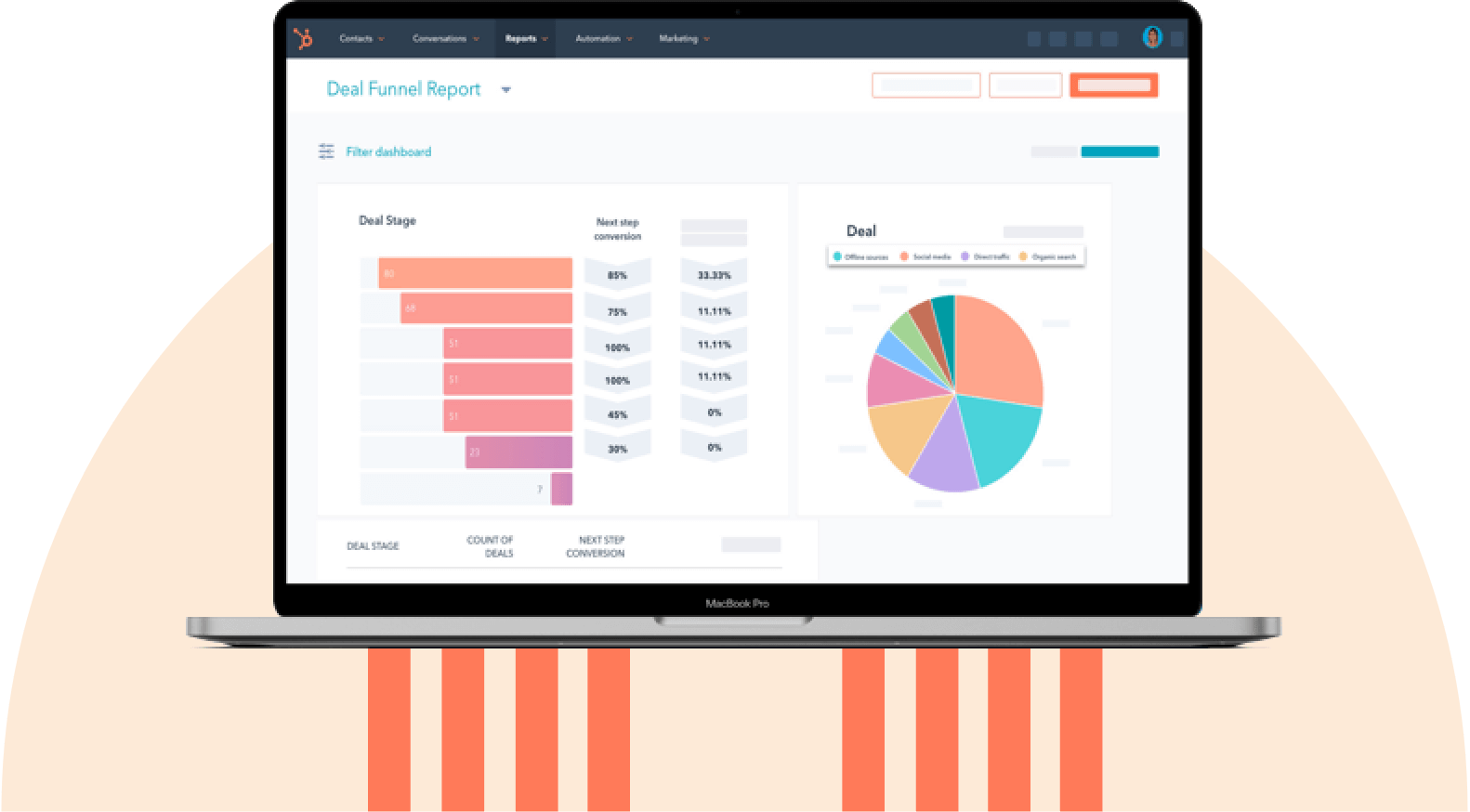









.png)